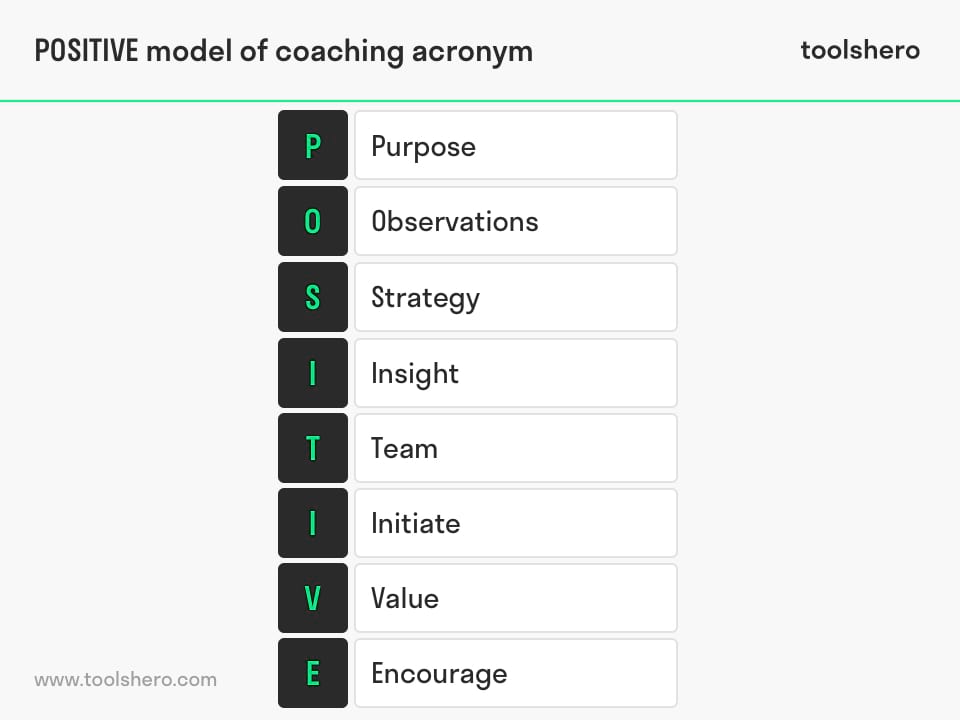POSITIVE Model of Coaching

POSITIVE model of coaching: this article provides a practical explanation of the POSITIVE model of coaching. Next to what it is, this article also highlights the acronym and the application of this coaching model. After reading, you will understand the basics of this powerful coaching framework and management tool. Enjoy reading!
What is the POSITIVE model of coaching?
Coaching can be defined in many ways, but the main goal of coaching is to help people change or help them achieve personal goals. The POSITIVE model of coaching is as the name suggest concerned with the positive experiences of people.
The model attempt to identify positive experiences of people and next see if these experiences can be used to achieve current set goals. The underlying thought is that people can get rid of personal fears and that a positive mindset will help them achieve goals.
The POSITIVE model of coaching is developed from the GROW model, ARROW model, and ACHIEVE model. The POSITIVE model of coaching is an extension of these models and include some aspects of psychology.
The POSITIVE model of coaching helps people create clear and concrete goals, even if the initial goal is vague and broad. These goals are next scaled, made quantifiable, and obtainable for the person. By using this model, it immediately creates clarity about what people really try to accomplish.
The POSITIVE model of coaching attempt to identify the coachee’s obstacles that could occur when they are trying to achieve their goals. The model simulates the coachee to think about creative ways to mitigate challenges that stand in the way of achieving goals. The way to deal with challenges can be based on positive past experiences. According to the model, it is important to learn from positive examples because it helps to succeed in the future.
The positive past examples serve as a solution for current weaknesses. These can also serve as motivation to continue making progress based on a positive mindset. The POSITIVE model of coaching additionally attempt to address how people remain motivated but also what kind of resources are required that will help to achieve their goals. Finally, the POSITIVE model of coaching evaluates the extent to which goals are achieved, how newly acquired skills can be used for other challenges, and how the person feels about new challenges.
POSITIVE
POSITIVE of the positive model of coaching stands for the following:
- Purpose
- Observations
- Strategy
- Insight
- Team
- Initiate
- Value
- Encourage

Figure 1 – the acronym of the POSITIVE model of coaching
1. Purpose
The first step in the POSITIVE model of coaching is to identify the real goal is. It is for this reason essential to clarify what is expected from the relationship with the coach and the coachee. Because of this, it is best to specify the expected result of each session.
In order to best serve this function in the coaching process, it is crucial to actively listen to what an individual wants to achieve.
Sometimes people think they are dealing with a problem while the root of the problem lies deeper than they expected. For example, if a coachee does not perform well at work, others could evaluate what does not work and what needs to be improved.
However, the person who is dealing with a problem might suffer from depression which is also caused by other factors.
Attempting to enhance operational skills, for example, would in this case not help improve the performance of the person. The possession of the right mix of communication skills is for this reason important to establish a foundation to start the coaching process.
2. Observations
This part of the POSITIVE model of coaching is concerned with formulating the full view of why a change is needed, and if not, who or what will be affected by a problem. The objective is to identify where issues arise and where it has an impact. In this way, a clear overview will be created of positives and negative aspects of a person’s environment.
It additionally helps to make rational decisions on in the coaching process, and it helps to conclude if coaching is actually needed.
3. Strategy
If the POSITIVE model of coaching will be further applied, it is in this step essential to formulate goals to make ambitions clearer, more concrete, and realistic. It is crucial to understand that the coach does not formulate goals.
It is up to the coachee to formulate its own goals. These must be challenging but also must be achievable with regards to knowledge, skills, and resources. For this reason, the goals must be SMART formulated.
4. Insight
When the goals are formulated, it is now important to obtain insights about an individual’s emotions or thoughts when he or she think about accomplishing the goals.
This is important because the way of thinking influence the likelihood the goal is going to be achieved. It thus additionally determines if it is realistic or not. If a coachee feels overwhelmed or scared about the thought of achieving a goal, the goal is for the coachee too difficult to achieve and it should therefore be adjusted. This part of the POSITIVE model of coaching for this reason also identifies if the goal really is what the person wants.
5. Team
The objective in this element in the POSITIVE model of coaching is to find partners who can assist the coachee with achieving its goals. According to psychological research, social support stimulates individuals’ ability to deal with changes. It is therefore important for the coachee to identify people to share these goals with.
When the coachee experience difficulties when trying to achieve its goals, he or she then has a team to communicate this with. The chance that the coachee will continue the goal path will as a result be higher.
6. Initiate
This is the implementation phase of the POSITIVE model of coaching. At this point, the previous formulated SMART goals’ action points, which are now scaled, are going to be executed. The coach must at this stage stimulate the coachee to actively work towards the goals.
7. Value
Since the goals that were designed have to be challenging, the likelihood that it is a long-term process before the goals are achieved is high. Because of this, it is crucial to scale the goal into various milestones.
The milestones will help drive the coachee to accomplish its objective without getting distracted of demotivated to accomplish the long-term goal.
By using milestones, it is additionally going to be easier to discuss the performance progress, but it will also be more clear about how committed the coachee is to reach the initial goal still. Since the milestones are indicators of short-term progress, the coach and coachee can quickly respond to obstacles.
If these occur, it will simultaneously be clear if the coachee’s drive to achieve its goal declines, remains the same, or increases.
8. Encourage
The final element of the POSITIVE model of coaching deals with the amount of encouragement the coach provides to the coachee. Based on the POSITIVE model of coaching, encouragement is not only needed from the coachee’s social support network but also from the coach.
The coach is the first person who the coachee will contact for help. For this reason, it is expected that the coach has a proactive attitude to motivate the coachee continually. This motivation can be stimulated by additional interaction instead of solely coaching sessions, for example.
This means, it is the coach’s job to call, e-mail, or even send a card to the coachee to demonstrate the coach believes in the coachee to achieve its goal. This will work as an encouragement to achieve the goals, and thus, increases its effectiveness of coaching.
Application of the POSITIVE model of coaching
The following steps of the POSITIVE model of coaching serve as an example. Every coach and coachee are different, and there is no defined right or wrong way of coaching. However, this model allows the coach to use its own personality and coaching style.
1. Purpose
The first step is essential because it creates a foundation to start working. It is crucial to understand the real problem, and thus, why the coachee really needs help. In this step, the coach could ask questions such as:
- What do you want to accomplish?
- What do you expect from the coach?
- What other ideas do you have that will help you achieve your goal?
2. Observe
After the purpose has been identified, the objective of this step is to analyze the coachee’s environment. As explained previously, it is in this step important to understand why coaching is needed and where an impact could occur if coaching would not take place. In order to observe the environment, the following questions could be taken into consideration:
- What are you proud of and what are not proud of?
- What things are happening at this moment?
- What initiatives have already worked in previous times?
- With who have you shared your ambitions?
3. Strategy
At this point, the foundation is created. The next step is determining if coaching will continue. If it does, goals have to be SMART formulated in order to make it clear, concrete, and realistic. It is of high importance that the coachee creates its personal goals, but the coach can help to create these by asking the following type of questions:
- What do you want to achieve?
- How can you measure the success of your goal?
- What time limit do you give yourself to accomplish this goal?
4. Insight
In this step of the POSITIVE model of coaching, it is important to understand the personal drive or motivation of the coachee. The model attempts to identify the coachee’s feelings about achieving particular goals. The following questions could be considered to ask but are not limited to these:
- Can you explain how challenging this goal is for you?
- How dedicated are you to achieve these goals?
- Are there obstacles you have not considered yet?
5. Team
The coachee has now created its goals, knows its direction, and have the drive to achieve its goals. It is now important in the POSITIVE model of coaching to create a support network. It is essential because it identifies people to rely on when a coachee experience difficulties or get demotivated to achieve its goals. In order to identify the right mix of people that can help the coachee to achieve its goals, the coach could ask for instance:
- What type of support do you think you need to accomplish your goals?
- Which people have already supported you in the past?
- What gives you drive or motivation when you experience a setback?
6. Initiate
This step is part of the implementation of work towards the goal. The goals have been formulated, and a support team is created. It is now important to determine where and how to start. The coach can help the coachee by asking for instance:
- When will you start?
- How will you begin?
- How will you act when things do not work out as you planned or expected?
7. Value
At this point in the POSITIVE model of coaching, the coachee is working on the goal, but it is important that value is continually created. As described, smaller steps are created that deliver value, but it is also important to ask, for example, the following questions:
- What is feeling about achieving this step?
- How will you celebrate the achievement of a milestone?
- Are you going to continue attempting to reach your goal?
8. Encourage
In the last step, as explained, to provide effective coaching, it is crucial to encourage the coachee regularly. When the coach demonstrates to believe in the coachee, the coachee is more likely to continue achieving the set goals. The following questions could be asked:
- Did you experience setbacks in the meantime?
- Are you on schedule with your plans?
- How is it going with your goals?
Final word on the POSITIVE model of coaching
When the POSITIVE model of coaching is used, it is important to understand that it is a flexible framework. The above-described examples serve as an indication to know where to head to. It is important to understand that the coachee has top priority and that all insights must be provided by the coachee.
In order to realize this and to be effective, the coach must have excellent communication skills. Many follow-up questions may be required that will help identify the root of problems.
Now it’s your turn
What do you think? Are you familiar with this explanation of the POSITIVE model of coaching? Are familiar with this model or have you already worked with this coaching model? Do you have any tips or additional comments?
Share your experience and knowledge in the comments box below.
More information
- Dembkowski, S., & Eldridge, F. (2003). Beyond GROW: A new coaching model. The international journal of mentoring and coaching, 1(1), 21.
- Edgerton, N., & Palmer, S. (2005). SPACE: A psychological model for use within cognitive behavioural coaching, therapy and stress management. The Coaching Psychologist, 1(2), 25-31.
- Libri, V. (2004). Beyond GROW: In search of acronyms and coaching models. The International Journal of Mentoring and Coaching, 2(1), 1-8.
- Palmer, S. (2007). PRACTICE: A model suitable for coaching, counselling, psychotherapy and stress management. The Coaching Psychologist, 3(2), 71-77.
How to cite this article:
Zeeman, A. (2019). POSITIVE model of coaching. Retrieved [insert date] from Toolshero: https://www.toolshero.com/management/positive-model-of-coaching
Original publication date: 10/17/2019 | Last update: 09/27/2023
Add a link to this page on your website:
<a href=”https://www.toolshero.com/management/positive-model-of-coaching/”>Toolshero: POSITIVE model of coaching</a>












